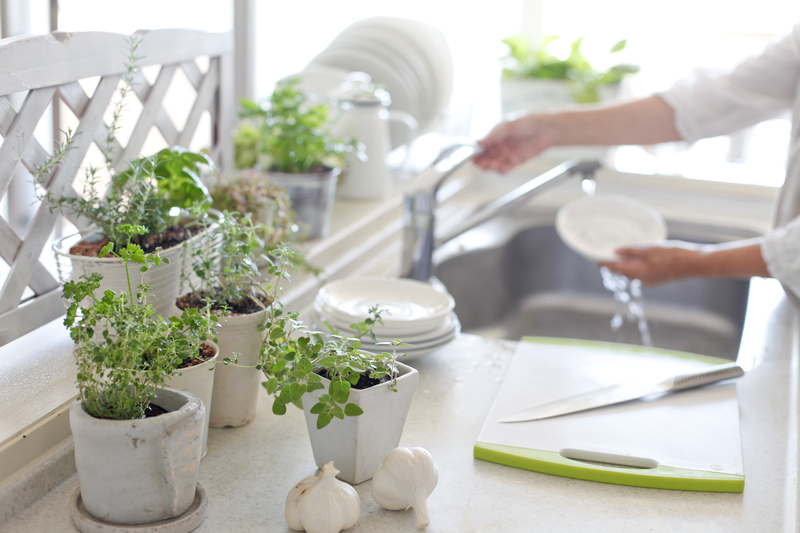Resilient Gardening for Harsh Weather Scenarios
Posted on 04/06/2025
Resilient Gardening for Harsh Weather Scenarios: Your Comprehensive Guide
As climate change continues to impact ecosystems worldwide, resilient gardening has become not only desirable but essential. From fierce winds to severe droughts and frosty blizzards, gardeners must find innovative gardening strategies that withstand unpredictable weather. In this comprehensive guide, we'll delve into the best practices, plant selections, and landscape techniques to ensure your garden thrives--no matter what Mother Nature throws your way.

Understanding Resilient Gardening in Extreme Conditions
Resilient gardening is the art and science of designing, cultivating, and managing gardens in ways that buffer them against environmental stressors. The primary goal is to create landscapes that endure--and even flourish--amid challenging weather conditions. This can include:
- Drought
- Floods
- Extreme heat
- Cold snaps or frosts
- Storms and high winds
With a well-thought-out plan, you can make your garden more weather-resilient and less dependent on outside inputs.
Why Is Resilience Important in Modern Gardening?
Global weather patterns are increasingly unpredictable. Extreme weather events can wipe out years of cultivation in a single season. By adopting weather-resilient gardening tactics, you can minimize loss, protect biodiversity, conserve resources, and save time and money. Most importantly, you contribute to a healthier environment and ensure food security at a local level.
Best Practices for Resilient Gardening in Harsh Weather
1. Site Analysis: Observe and Adapt
Understanding the unique microclimate of your garden is the cornerstone of creating a resilient garden. Spend time observing:
- Sun and shade patterns throughout the year
- Areas susceptible to flooding or drought
- Natural windbreaks and exposure points
- Soil type and drainage quality
Take detailed notes and consider how these elements shift with seasons. Successful climate-resilient gardening means making your plan flexible to adapt with natural changes.
2. Soil Health: The Foundation of Resilience
Healthy soils are nature's ultimate shock absorbers. They retain moisture in a drought, drain quickly during floods, and buffer plants from temperature extremes.
- Add organic matter: Compost, leaf mold, and well-rotted manure boost soil resilience by improving structure and microbial activity.
- Mulch generously: Mulches protect roots from extreme heat, cold, and erosion. Use straw, wood chips, or bark as a natural insulator.
- Avoid chemical overuse: Harsh fertilizers and pesticides can degrade soil health over time, making plants more vulnerable to stress.
*Tip: Regularly test your soil and amend it as needed to maintain optimal balance for your chosen plants.*
3. Smart Plant Selection for Weather-Resilient Gardens
Plant choice is critical for ensuring survival in tough weather. Select species that are:
- Disease-resistant
- Locally adapted/native
- Drought-tolerant or flood-tolerant, depending on your climate
- Root-deep and low-maintenance
Using a mix of perennials, annuals, shrubs, and trees increases garden biodiversity and reduces the likelihood that one harsh event will wipe out everything.
Examples of Tough, Resilient Plants:
- Drought-resilient: Lavender, yarrow, sedum, salvia, Russian sage, coneflower, agastache
- Flood-tolerant: Bald cypress, sweet flag, cardinal flower, umbrella plant
- Heat-resistant: Blanket flower, lantana, agave, rosemary
- Cold-hardy: Hosta, daylily, Siberian iris, peony
*Explore with local nurseries for native options that thrive in your region's unique conditions.*
4. Smart Garden Design for Weather-Resilience
A well-designed landscape withstands harsh weather with grace. Consider these elements:
- Diversify layout: Mix plant heights and structures to create microclimates and windbreaks.
- Create swales and berms: Guide excess water away from sensitive areas in heavy rains.
- Group plants by water need: Zoning helps optimize irrigation and resilience in dry spells.
- Utilize hardscaping: Gravel paths, rocks, and raised beds provide stability and improved drainage.
Strategic planting not only increases visual appeal but also naturally protects your garden from the worst weather extremes.
5. Water Management in Harsh Weather Gardens
Water conservation and management are at the heart of resilient gardening. Whether facing flood or drought, you need to manage water efficiently.
Drought Scenarios:
- Install drip irrigation: Target roots directly, reducing evaporation and waste.
- Harvest rainwater: Set up barrels or cisterns for dry spells.
- Water at the right time: Early morning or evening reduces loss through evaporation.
- Prioritize established plants: Young plants need extra help during extreme conditions.
Flood or Heavy Rain:
- Elevate beds: Raised beds prevent waterlogging of root systems.
- Improve drainage: Use organic matter and gritty amendments to enhance quick runoff.
- Plant in mounds or hills: Encourage water flow away from roots.
- Add rain gardens: Collect and filter stormwater naturally, increasing overall resilience.
Extreme Weather Challenges and Solutions for Resilient Gardens
A. Coping with Drought and Heatwaves
Hot, dry spells are increasingly common in many regions. Try these techniques to bolster your drought-resistant garden:
- Apply deep mulching: Maintain even soil moisture and suppress evaporation.
- Choose greywater systems: Reuse household water on ornamentals (never on edibles without special filtration).
- Shade tender plants: Use shade cloth or plant shade trees in strategic locations.
- Soak, don't sprinkle: Deep, infrequent watering encourages deep root growth, making plants more resilient to drought conditions.
B. Resilient Gardening Against Flooding and Heavy Rain
Flooding can wash away nutrients and invite disease. For a flood-resilient garden:
- Build rain gardens: Direct run-off into garden zones filled with absorbent plants.
- Plant cover crops: These prevent soil erosion and fix nutrients through restoration after floods.
- Use permeable hardscapes: Gravel or pavers allow rain to seep in instead of pooling on the surface.
- Regularly aerate soil: Well-aerated soil drains more quickly, reducing root rot risk.
C. Surviving High Winds and Storms
Storms can uproot trees, break branches, and flatten delicate plants. A truly wind-resilient garden incorporates these strategies:
- Create living windbreaks: Rows of hedges, sturdy shrubs, or strategically planted trees reduce wind speed.
- Stake young trees: Support them until their roots anchor deeply in the soil.
- Install flexible plant supports: Short, broad stakes or cages for tall flowers protect them from being flattened.
- Regularly prune: Remove weak or dead branches to minimize breakage risk during storms.
D. Preparing for Cold Snaps and Late Frosts
Unseasonable frosts can devastate early growth. For a cold-resilient garden:
- Use floating row covers: Lightweight fabric insulates without suffocating plants.
- Choose frost-tolerant cultivars: Many vegetables and ornamentals have cold-hardy varieties.
- Mulch for insulation: Thick winter mulch protects root systems and soil structure.
- Plant at the right time: Avoid premature planting; check local frost dates reliably.
Innovative Techniques for Building Weather-Resilient Gardens
Polycultures and Companion Planting
*Monocultures are vulnerable; diversifying your plantings mimics nature's own insurance policies.* Interplant a variety of crops and flowers so pests, diseases, or harsh weather are less likely to wipe out your entire garden in one go. Companion planting also allows for:
- Pest control
- Disease suppression
- Wind buffering
- Efficient use of resources
Perennial Crops and Ground Covers
Perennial plants and ground covers are the backbone of a climate-resilient landscape. Their deep root systems stabilize soil, cycle nutrients, and survive most seasonal threats. Consider:
- Asparagus, rhubarb, globe artichokes (perennial vegetables)
- Strawberries, creeping thyme, clover (ground covers)
- Native wildflowers for pollinators and soil health
Embracing Regenerative Gardening Principles
Resilient gardening borrows from regenerative agriculture, focusing on practices that build up natural systems. Examples include:
- No-till gardening to protect soil structure
- Cover cropping to add biomass and cycle nutrients
- Composting to foster a living soil ecosystem
- Minimizing disturbance, so natural structures absorb shocks
Over time, these methods increase your garden's self-sufficiency and long-term resistance to climate extremes.
Resilient Gardening Tools and Technologies
Smart Sensors and Automation
Technology can greatly improve climate-resilient garden management. Soil moisture sensors, automated irrigation systems, and weather alerts help you:
- Apply the right amount of water, only when needed
- Respond quickly to flash drought or flood warnings
- Track plant health remotely
*These tools are invaluable for reducing labor, conserving water, and ensuring timely interventions when harsh weather hits.*
Protective Structures
Simple garden structures can make all the difference:
- Hoop houses and cold frames: Extend the growing season and shelter crops from sudden frost or wind.
- Shade cloths: Protect against scorching sun during heatwaves.
- Wind fences: Temporary or permanent, they reduce breakage during strong storms.

Community and Biodiversity: The Broader Impact of Resilient Gardening
Resilient gardens don't just benefit the gardener--they contribute to a larger ecological network:
- Boost biodiversity by providing habitats for pollinators, beneficial insects, and birds
- Enhance local food security with more dependable yields
- Reduce pressure on municipal resources by managing stormwater and reducing energy use
- Foster a sense of community through knowledge-sharing and collective action
Engage neighbors in weather-resilient gardening clubs and seed swaps, or participate in community gardens that use these resilient techniques for collective benefit.
Conclusion: Start Building Your Weather-Resilient Garden Today
A lush, productive landscape is possible--even in the face of climate uncertainty. By applying the principles of resilient gardening for harsh weather scenarios, you'll safeguard your garden's future while reaping more reliable harvests and blooms today. Focus on healthy soils, thoughtful plant selection, smart design, efficient water management, and community involvement. With a little planning and experimentation, your garden can become not only a place of beauty, but a symbol of resilience and hope for the future.
Ready to make your garden more climate-resilient? Share your own tips and stories in the comments and browse our additional resources to keep learning and growing, no matter what the weather brings.

